外研版八年级上册:Module 6 Animals in danger单元精美教案
- 格式:doc
- 大小:258.50 KB
- 文档页数:18
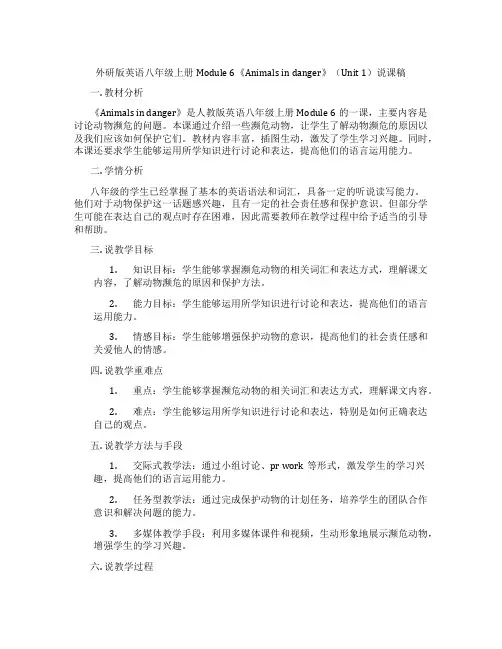
外研版英语八年级上册Module 6《Animals in danger》(Unit 1)说课稿一. 教材分析《Animals in danger》是人教版英语八年级上册Module 6的一课,主要内容是讨论动物濒危的问题。
本课通过介绍一些濒危动物,让学生了解动物濒危的原因以及我们应该如何保护它们。
教材内容丰富,插图生动,激发了学生学习兴趣。
同时,本课还要求学生能够运用所学知识进行讨论和表达,提高他们的语言运用能力。
二. 学情分析八年级的学生已经掌握了基本的英语语法和词汇,具备一定的听说读写能力。
他们对于动物保护这一话题感兴趣,且有一定的社会责任感和保护意识。
但部分学生可能在表达自己的观点时存在困难,因此需要教师在教学过程中给予适当的引导和帮助。
三. 说教学目标1.知识目标:学生能够掌握濒危动物的相关词汇和表达方式,理解课文内容,了解动物濒危的原因和保护方法。
2.能力目标:学生能够运用所学知识进行讨论和表达,提高他们的语言运用能力。
3.情感目标:学生能够增强保护动物的意识,提高他们的社会责任感和关爱他人的情感。
四. 说教学重难点1.重点:学生能够掌握濒危动物的相关词汇和表达方式,理解课文内容。
2.难点:学生能够运用所学知识进行讨论和表达,特别是如何正确表达自己的观点。
五. 说教学方法与手段1.交际式教学法:通过小组讨论、pr work等形式,激发学生的学习兴趣,提高他们的语言运用能力。
2.任务型教学法:通过完成保护动物的计划任务,培养学生的团队合作意识和解决问题的能力。
3.多媒体教学手段:利用多媒体课件和视频,生动形象地展示濒危动物,增强学生的学习兴趣。
六. 说教学过程1.导入:教师通过提问方式引导学生谈论他们喜欢的动物,引出本课主题。
2.呈现:教师通过展示濒危动物的图片和视频,呈现本课的主要内容。
3.讲解:教师讲解课文内容,帮助学生理解动物濒危的原因和保护方法。
4.实践:学生进行小组讨论,讨论如何保护动物,并完成保护动物的计划任务。
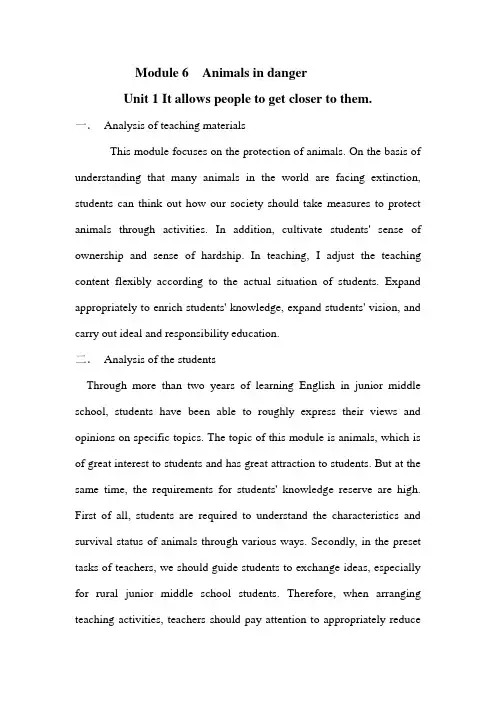
Module 6 Animals in dangerUnit 1 It allows people to get closer to them. 一.Analysis of teaching materialsThis module focuses on the protection of animals. On the basis of understanding that many animals in the world are facing extinction, students can think out how our society should take measures to protect animals through activities. In addition, cultivate students' sense of ownership and sense of hardship. In teaching, I adjust the teaching content flexibly according to the actual situation of students. Expand appropriately to enrich students' knowledge, expand students' vision, and carry out ideal and responsibility education.二.Analysis of the studentsThrough more than two years of learning English in junior middle school, students have been able to roughly express their views and opinions on specific topics. The topic of this module is animals, which is of great interest to students and has great attraction to students. But at the same time, the requirements for students' knowledge reserve are high. First of all, students are required to understand the characteristics and survival status of animals through various ways. Secondly, in the preset tasks of teachers, we should guide students to exchange ideas, especially for rural junior middle school students. Therefore, when arranging teaching activities, teachers should pay attention to appropriately reducethe difficulty and let students actively participate in classroom teaching. 三.Teaching objectives1. Language knowledge objectivesVocabulary: thin danger protect enough raisePhrases and sentences: In danger, take away, in peace, look after, be excited to do, need to doGrammar: verb infinitiveFunction: how to protect animalsTopic: discuss how to protect animals on the basis of understanding the current situation of animal survival.nguage skills objectivesListening: Students can understand the dialogue about animals. Speaking: Students are able to use the to do structure to discuss specific topics.Reading: Students are able to read articles related to animals. Writing: Students are able to use the to do structure to correctly express views and opinions.3. Learning strategy objectivesCooperative learning strategy: Students can care about the survival status of animals living around, discuss and share their views and write the final view.4. Emotional attitude objectivesEnhance students' awareness of caring for our homes and protecting the ecological environment, and stimulate their enthusiasm to save animals from me and small things around them.四.Key and difficult points of teaching1. Teaching focus: Teacher help students to learn verb infinitive.2. Teaching difficulties: Teacher help students to correct the use of verb infinitives.Teacher help students to express properly how to protect endangered animals.五.Teaching proceduresLeading Step 1:Show some pictures aboutanimals and guess their name.Ts: Guess Name: Who am I?Ss: Bear elephant giraffe lion snakeStep2: Use the words to finish the quiz. 2: Step 1: Predication: Before listenig, the 3: Step1: Extensive listeningAsk students to listen the material to choose the best answer and check their predictions.Step 2: Intensive listeningStudents should listen the material again and do the following tasks.Activity 1: True and falseActivity 2: Role play 4: Step 1: Pair work Step 2:plete the passage5: the。
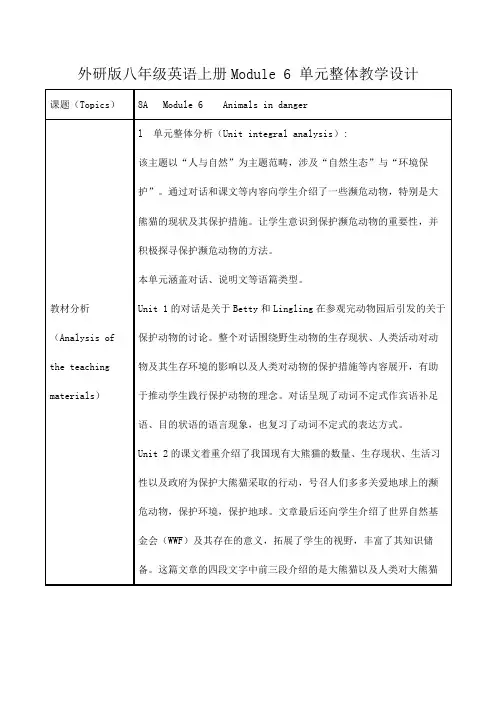
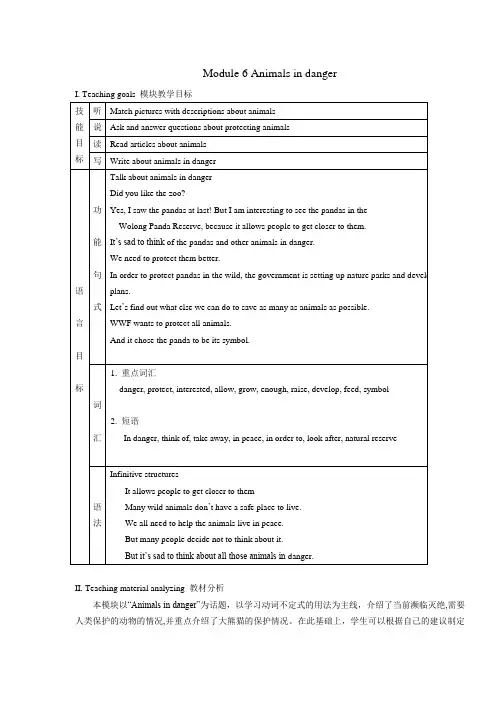
Module 6 Animals in dangerI. Teaching goals 模块教学目标II. Teaching material analyzing 教材分析本模块以“Animals in danger”为话题,以学习动词不定式的用法为主线,介绍了当前濒临灭绝,需要人类保护的动物的情况,并重点介绍了大熊猫的保护情况。
在此基础上,学生可以根据自己的建议制定更合理的动物保护措施;模块同时通过该话题还复习了一般现在时、现在进行时、一般过去时、一般将来时的用法。
III.Class types and periods 课型设计与课时分配Period 1 Listening and speakingPeriod 2 GrammarPeriod 3 Reading and writingPeriod 4 Language in useIV. Teaching plans for each period分课时教案Period 1 Listening and speakingLanguage goals 语言目标1.Key vocabulary 重点词汇danger, protect, interested, allow, grow, enough, raise, in danger, think of, take away, in peace, in order to, look after2.Key structures 重点句式I saw the pandas at last.I am (not) interested / sad/ right/ hard to do sth.need/ decide(not) to do sth.It’s sad to think of the pandas and other animals in danger.Ability goals 能力目标Enable students to talk about animals in danger.Teaching methods 教学方法Listening and speaking.Teaching aids 教具准备Tape recorder.Teaching procedures and ways 教学过程与方式Step I Warming-upTalk about animals.T: Animals are our friends. We should learn to live together with animals. Many families now havepets at home. That is, human beings are living with animals. They are pet animals. What pet animals do you know?S: Cats, dogs, rabbits, etc.T: Do any family keep tiger, lion, elephant, etc as pet animals?S: No.T: Do you know why?S: Because they are dangerous.S: Because they are too difficult to keep.…T: Good. Just think about this: Where do these animals live? What do they eat? What’s their situation like? Do you know?Encourage students to speak out what they have in mind.S: We can only see them in the zoo.S: People kill them to make money.S: We must protect them.…T: Quite true. From now on, we are going to talk about animals in danger. (emphasize the phrase “in danger”).Now please look at activity 1 on page 42.Ask students to complete the quiz with the words in the box, check the answers and then read each word twice loudly.Step II Listening and readingListeningFirst ask students to read the questions in activity 2 and get them to take notes while listening. Then listen and check the answers.Then ask them to listen to the conversation between Lingling and Betty carefully with their books closed. And then complete the table.StepⅢReadingAsk students to read after the tape first. Work in pairs and read the conversation repeatedly and then ask some pairs to act out the conversation.Ask students to find out the infinitive structures in the conversation and read them together.Read through the word and expressions in the box with the whole class and have them repeat them chorally and individually.Ask students complete the passage individually, and then check with partner.Call back the answers from the whole class.StepⅣDealing with the key words and expressions.1. be interested ininterested adj.“关心的,感兴趣的”,其主语一般指人。
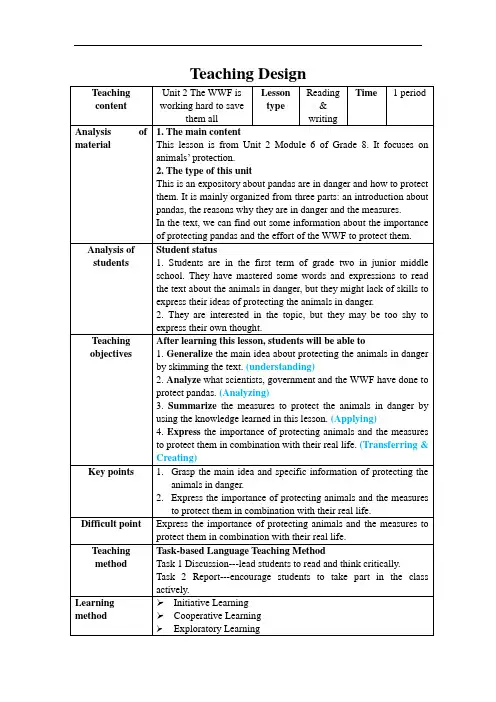
Teaching DesignTeacher activity Student activitythe 1. Guessing game.2. Teach the new phrases.a symbol of, in danger 1. Guessing game.2. Learn the new phrases.a symbol of, in dangerPurposethe 1. Read the passage and match the headings with theparagraphs.2. Generalize the structure.3. Read the passage carefullyand answer the questions.1. Read the passage and match the headings with the paragraphs.2. Generalize the structure.3. Read the passage carefully and answer the questions.Purpose2. Thinking Quality---to analyze the text.1. Work in groups. Retell the passage with your own words.2. Discuss the question.Can you think of other ways to protect animals? 1. Work in groups. Retell the passage with your own words. S1: Pandas are in danger and the situation is getting very difficult. But scientists and government are trying to take action to save them. Also, the WWF chose the panda to be its symbol and it is working hard to save them all.S2: There are few pandas and they are losing their home. But the scientists, government and the WWF is making efforts to protect them.2. Discuss the question.Can you think of other ways to protect animals?Purpose。
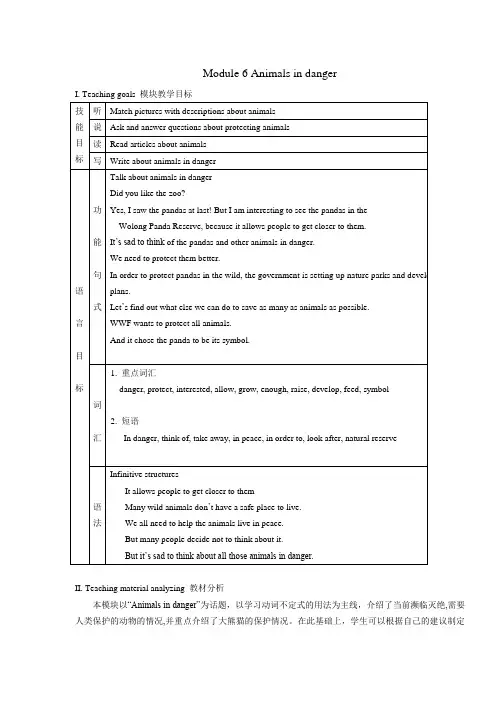
Module 6 Animals in dangerI. Teaching goals 模块教学目标II. Teaching material analyzing 教材分析本模块以“Animals in danger”为话题,以学习动词不定式的用法为主线,介绍了当前濒临灭绝,需要人类保护的动物的情况,并重点介绍了大熊猫的保护情况。
在此基础上,学生可以根据自己的建议制定更合理的动物保护措施;模块同时通过该话题还复习了一般现在时、现在进行时、一般过去时、一般将来时的用法。
III.Class types and periods 课型设计与课时分配Period 1 Listening and speakingPeriod 2 GrammarPeriod 3 Reading and writingPeriod 4 Language in useIV. Teaching plans for each period分课时教案Period 1 Listening and speakingLanguage goals 语言目标1.Key vocabulary 重点词汇danger, protect, interested, allow, grow, enough, raise, in danger, think of, take away, in peace, in order to, look after2.Key structures 重点句式I saw the pandas at last.I am (not) interested / sad/ right/ hard to do sth.need/ decide(not) to do sth.It’s sad to think of the pandas and other animals in danger.Ability goals 能力目标Enable students to talk about animals in danger.Teaching methods 教学方法Listening and speaking.Teaching aids 教具准备Tape recorder.Teaching procedures and ways 教学过程与方式Step I Warming-upTalk about animals.T: Animals are our friends. We should learn to live together with animals. Many families now havepets at home. That is, human beings are living with animals. They are pet animals. What pet animals do you know?S: Cats, dogs, rabbits, etc.T: Do any family keep tiger, lion, elephant, etc as pet animals?S: No.T: Do you know why?S: Because they are dangerous.S: Because they are too difficult to keep.…T: Good. Just think about this: Where do these animals live? What do they eat? What’s their situation like? Do you know?Encourage students to speak out what they have in mind.S: We can only see them in the zoo.S: People kill them to make money.S: We must protect them.…T: Quite true. From now on, we are going to talk about animals in danger. (emphasize the phrase “in danger”).Now please look at activity 1 on page 42.Ask students to complete the quiz with the words in the box, check the answers and then read each word twice loudly.Step II Listening and readingListeningFirst ask students to read the questions in activity 2 and get them to take notes while listening. Then listen and check the answers.Then ask them to listen to the conversation between Lingling and Betty carefully with their books closed. And then complete the table.StepⅢReadingAsk students to read after the tape first. Work in pairs and read the conversation repeatedly and then ask some pairs to act out the conversation.Ask students to find out the infinitive structures in the conversation and read them together.Read through the word and expressions in the box with the whole class and have them repeat them chorally and individually.Ask students complete the passage individually, and then check with partner.Call back the answers from the whole class.StepⅣDealing with the key words and expressions.1. be interested ininterested adj.“关心的,感兴趣的”,其主语一般指人。
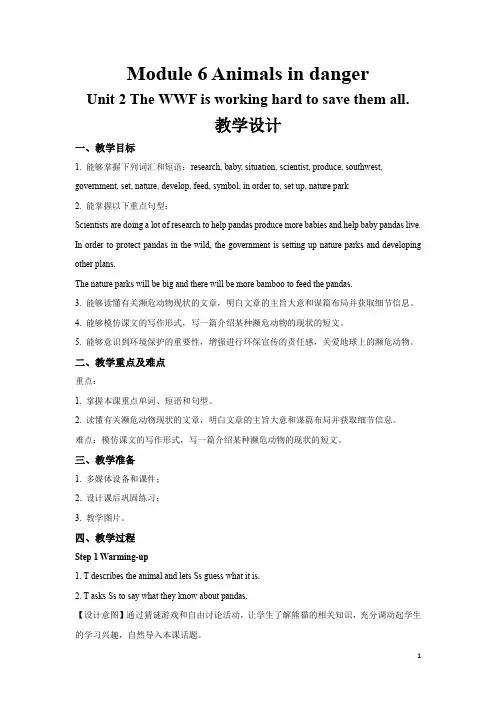
Module 6 Animals in dangerUnit 2 The WWF is working hard to save them all.教学设计一、教学目标1. 能够掌握下列词汇和短语:research, baby, situation, scientist, produce, southwest, government, set, nature, develop, feed, symbol, in order to, set up, nature park2. 能掌握以下重点句型:Scientists are doing a lot of research to help pandas produce more babies and help baby pandas live. In order to protect pandas in the wild, the government is setting up nature parks and developing other plans.The nature parks will be big and there will be more bamboo to feed the pandas.3. 能够读懂有关濒危动物现状的文章,明白文章的主旨大意和谋篇布局并获取细节信息。
4. 能够模仿课文的写作形式,写一篇介绍某种濒危动物的现状的短文。
5. 能够意识到环境保护的重要性,增强进行环保宣传的责任感,关爱地球上的濒危动物。
二、教学重点及难点重点:1. 掌握本课重点单词、短语和句型。
2. 读懂有关濒危动物现状的文章,明白文章的主旨大意和谋篇布局并获取细节信息。
难点:模仿课文的写作形式,写一篇介绍某种濒危动物的现状的短文。
三、教学准备1. 多媒体设备和课件;2. 设计课后巩固练习;3. 教学图片。
四、教学过程Step 1 Warming-up1. T describes the animal and lets Ss guess what it is.2. T asks Ss to say what they know about pandas.【设计意图】通过猜谜游戏和自由讨论活动,让学生了解熊猫的相关知识,充分调动起学生的学习兴趣,自然导入本课话题。
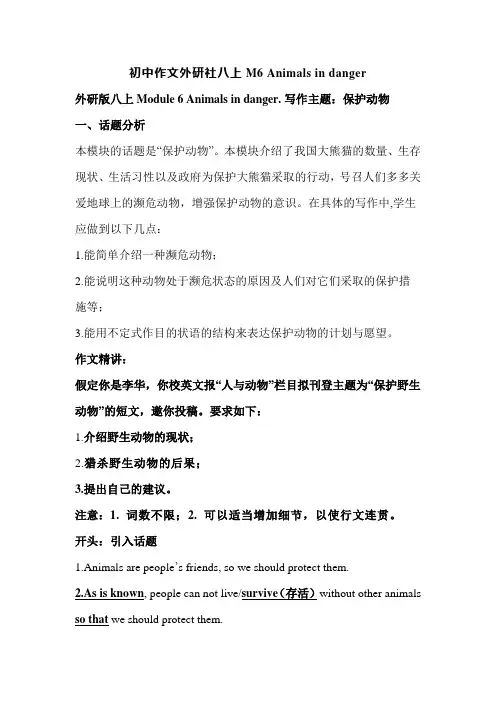
初中作文外研社八上M6 Animals in danger外研版八上Module 6 Animals in danger. 写作主题:保护动物一、话题分析本模块的话题是“保护动物”。
本模块介绍了我国大熊猫的数量、生存现状、生活习性以及政府为保护大熊猫采取的行动,号召人们多多关爱地球上的濒危动物,增强保护动物的意识。
在具体的写作中,学生应做到以下几点:1.能简单介绍一种濒危动物;2.能说明这种动物处于濒危状态的原因及人们对它们采取的保护措施等;3.能用不定式作目的状语的结构来表达保护动物的计划与愿望。
作文精讲:假定你是李华,你校英文报“人与动物”栏目拟刊登主题为“保护野生动物”的短文,邀你投稿。
要求如下:1.介绍野生动物的现状;2.猎杀野生动物的后果;3.提出自己的建议。
注意:1. 词数不限;2. 可以适当增加细节,以使行文连贯。
开头:引入话题1.Animals are people’s friends, so we should protect them.2.As is known, people can not live/survive(存活) without other animals so that we should protect them.3.I t is widely acknowledged/admitted that(普遍承认的是) people should live in harmony with(和谐) animals, or we will lose our earth one day.介绍野生动物的现状;1.However,many animals are in danger.2.However,many animals are in danger because people do harm to(伤害)them.For example,some people kill animals to sell them.Besides,a lot of animals are losing their homes.3.Unluckily/Unfortunately(不幸地),it is a pity that some animals are at the edge of(在…的边缘)dying out because of human activities.For example,some animals can provide precious medicine or fur,so people kill them fiercely(残忍地).猎杀野生动物的后果;1.If we kill animals too much,one day people will lose many kinds of animals.2.If we kill too many animals,one day we will pay the price(付出代价).We won't be able to eat some kinds of food if some kinds of animals die out(灭绝;死光).3.Killing too many animals will do harm to our humans in return(作为回报).Because we damage the ecosystem(生态系统),and we are a part of the ecosystem,too.提出自己的建议:1.As a result,we should do something to protect the animals.It is a good idea to build nature parks to give animals home.2.In that case(在这样的情况下),we should take steps(采取步骤)to protect animals.Building a nature park is an ideal(理想的)idea to provide endangered animals(濒危的动物)with home and food.3.Therefore,proper measures(适当的措施)should be taken to protect those endangered animals.For example,building a nature park to provide them with shelter(庇护所)and food,as well as raising everyone's awareness(提升每个人的意识)of animal protection is of great importance.结尾:1.I really hope everyone can do their part(尽自己的责任)to protect the animals.2.As long as(只要)we all care about animals,we can make a difference to all the animals.范文1:Animals are people's friends,so we should protect them.However,many animals are in danger.If we kill animals too much,one day people will lose many kinds of animals.As a result,we should dosomething to protect the animals.It is a good idea to build nature parks to give animals homes.I really hope everyone can do their part(尽自己的责任)to protect the animals.范文2:As is known,people can not live/survive(存活)without other animals so that we should protect them.However,many animals are in danger because people do harm to them.For example,some people kill animals to sell them.Besides,a lot of animals are losing their homes.In that case(在这样的情况下),we should take steps(采取步骤)to protectanimals.Building a nature park is an ideal(理想的)idea to provide endangered animals(濒危的动物)with homes and food.As long as(只要)we all care about animals,we can make a difference to all the animals.范文3:It is widely acknowledged/admitted that(普遍承认的是)people should live in harmony with(和谐)animals,or we will lose our earth one day. Unluckily/Unfortunately(不幸地),it is a pity that some animals are at the edge of(在…的边缘)dying out because of human activities.For example,some animals can provide precious medicine or fur,so people kill them fiercely(残忍地).Killing too many animals will do harm to ourhumans in return(作为回报).Because we damage the ecosystem,and we are a part of the ecosystem,too.Therefore,proper measures(适当的措施)should be taken to protect those endangered animals.For example,building a nature park to provide them with shelter(庇护所)and food,as well as raising everyone's awareness(提升每个人的意识)of animal protection is of great importance.As long as(只要)we all care about animals,we can make a difference to all the animals.。
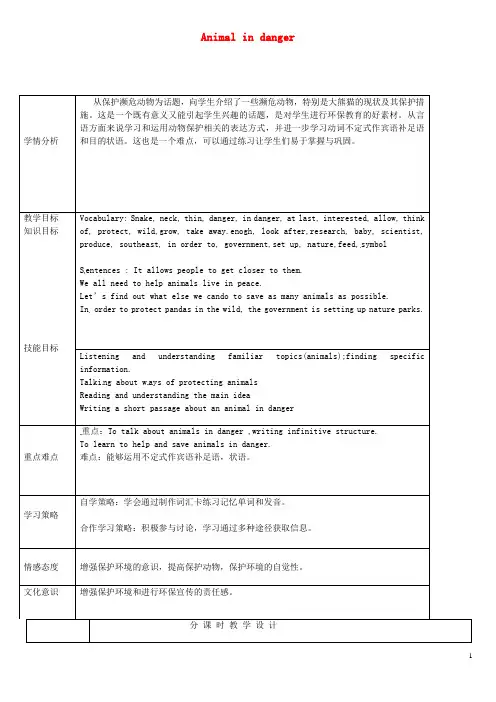
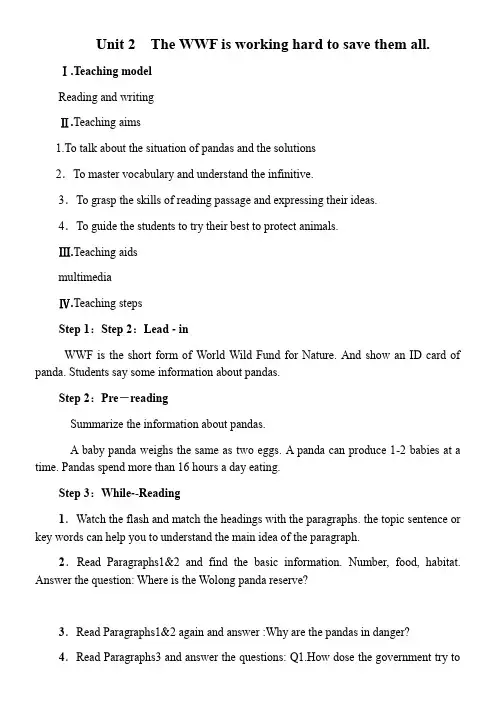
Unit 2The WWF is working hard to save them all.Ⅰ.Teaching modelReading and writingⅡ.Teaching aims1.To talk about the situation of pandas and the solutions2.To master vocabulary and understand the infinitive.3.To grasp the skills of reading passage and expressing their ideas.4.To guide the students to try their best to protect animals.Ⅲ.Teaching aidsmultimediaⅣ.Teaching stepsStep 1:Step 2:Lead - inWWF is the short form of World Wild Fund for Nature. And show an ID card of panda. Students say some information about pandas.Step 2:Pre-readingSummarize the information about pandas.A baby panda weighs the same as two eggs. A panda can produce 1-2 babies at a time. Pandas spend more than 16 hours a day eating.Step 3:While--Reading1.Watch the flash and match the headings with the paragraphs. the topic sentence or key words can help you to understand the main idea of the paragraph.2.Read Paragraphs1&2 and find the basic information. Number, food, habitat. Answer the question: Where is the Wolong panda reserve?3.Read Paragraphs1&2 again and answer :Why are the pandas in danger?4.Read Paragraphs3 and answer the questions: Q1.How dose the government try tosave the pandas? Q2.How is the nature park?5.Scan Paragraph 4 and check true sentences.Step 4:P ost-readingRetell the whole passage from the key words.Step 5:Watch a videoAnswer the questions: Do they really help pandas? Is the situation better? .Step 6: Work in pairsThere are some letters from animals in danger, What are the situations about them ? What can we do to help them? Make a dialogue to talk about them. Choose one letter to describe the situation and solutions.Step 7: WritingHi, everyone!This animal is ________.It lives in ____________.It likes to eat_______. The situation is getting___________. First,_______________________________; Second,_____________________________. So the scientists do a lot of research to help them.The WWF is working hard to save them all.Let’s protect them.Step 8: Emotional educationAnimals are our friends, not food. We should protect them! We must stop people from killing wild animals. To help animals is to help ourselves.。
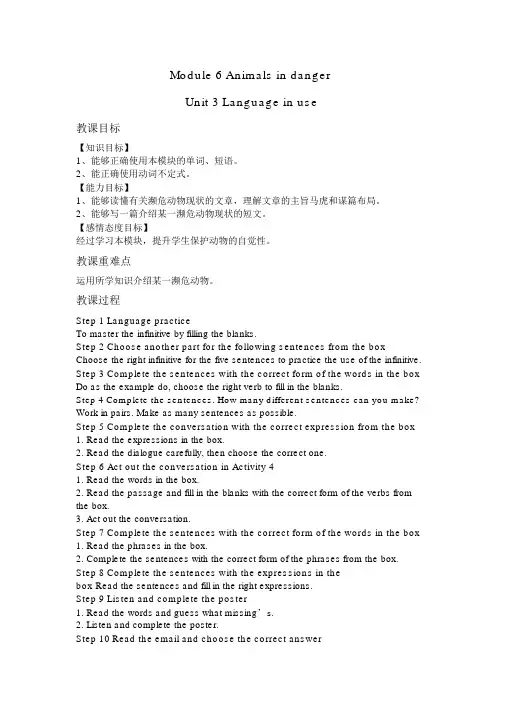
Module 6 Animals in dangerUnit 3 Language in use教课目标【知识目标】1、能够正确使用本模块的单词、短语。
2、能正确使用动词不定式。
【能力目标】1、能够读懂有关濒危动物现状的文章,理解文章的主旨马虎和谋篇布局。
2、能够写一篇介绍某一濒危动物现状的短文。
【感情态度目标】经过学习本模块,提升学生保护动物的自觉性。
教课重难点运用所学知识介绍某一濒危动物。
教课过程Step 1 Language practiceTo master the infinitive by filling the blanks.Step 2 Choose another part for the following sentences from the box Choose the right infinitive for the five sentences to practice the use of the infinitive. Step 3 Complete the sentences with the correct form of the words in the box Do as the example do, choose the right verb to fill in the blanks.Step 4 Complete the sentences. How many different sentences can you make? Work in pairs. Make as many sentences as possible.Step 5 Complete the conversation with the correct expression from the box1.Read the expressions in the box.2.Read the dialogue carefully, then choose the correct one.Step 6 Act out the conversation in Activity 41.Read the words in the box.2.Read the passage and fill in the blanks with the correct form of the verbs from the box.3.Act out the conversation.Step 7 Complete the sentences with the correct form of the words in the box1.Read the phrases in the box.plete the sentences with the correct form of the phrases from the box. Step 8 Complete the sentences with the expressions in thebox Read the sentences and fill in the right expressions.Step 9 Listen and complete the poster1.Read the words and guess what missing’s.2.Listen and complete the poster.Step 10 Read the email and choose the correct answer1.Read the email and get the main idea.2.Choose the correct answer to the three sentences.Step 11 Around the worldKnow about the animals in danger.Step 12 Discuss what you want people to know about the wildlife club Work in groups. Discuss the following questions:1. what animals you’ re going to help.2.when you ’ re going to meet.3.what you ’ re going to do.4.where you ’ re going to meet.Step 13 Make a poster about your wildlife clubWork in pairs. Let Ss make a poster together and choose the best one to show to the class.Step 14 Find out about the animals you want to help and add information to the poster to make it more interestingWork in pairs. Let Ss choose the animas freely and choose the best one to show. Step 15 ExercisesDo some exercises and draw the answers from the Ss.Step 17 Summary1.动词不定式的语法功能。
Module 6 Animals in danger Unit 2 The WWF is working hardto save them all.教材分析本课为Module 6的第二单元,课文着重介绍了我国现有大熊猫的数量、生存现状、生活习性以及政府为保护大熊猫采取的行动,号召人们多多关爱地球上的濒危动物,保护环境,保护地球。
教学目标●Knowledge objectiveKey vocabulary—research, baby, situation, scientist, produce, feed, government, nature, develop, symbolKey structures—nature park●Moral objective1. To help students know the importance of protecting animals and our environment.2. Improve their sense of duty to love and protect animals.教学重难点教学重点:1. To get information from the reading material about pandas.2. To learn some new words.教学难点:To understand the main idea of each paragraph of the article.课前准备A tape recorder, multimedia and some pictures教学过程Step 1 Lead-in1.Look at the pictures and guess what the animal is.2.Look at the pictures and answer the questions about the panda.Step 2 Say what you know about pandas.1.Work in pairs. Look at the pictures and say something about pandas.2.Elicit their ideas and put them under the headings on the board. Then use the facts theycome up with to pre-teach the key vocabulary.【设计意图】本活动是热身活动,旨在导入主题,引起学生兴趣。
课题:外研社版八年级上册Module 6 Animals in danger课型:群文阅读指导课教师:夹江县第二中学校韩茜设计理念:本节课是外研社版八年级上册英语Module 6群文阅读指导课。
本节课以Animals in danger 为中心话题选择了三篇关于熊猫、东北虎和金丝猴三种濒危动物的文章。
由于教材中本模块第二单元的课文是关于熊猫的,学生学了课文以后,对熊猫的话题比较熟悉,所以第一篇文章就是关于熊猫的,目的在于复习课文中的内容和新单词。
三篇文章都是让学生以先阅读,再画思维导图,最后做阅读后的训练题为模式,来训练学生的群文阅读能力。
最后揭示整节课的主题一Love animals. Protect animals.教学重点:1、激发学生对动物的喜爱和产生对濒危动物的保护意识。
2、进一步熟悉课文中的新单词,能读懂关于动物的文章,并在读懂文章的基础上,学会抓住文章中的重点词并画出思维导图。
3、训练学生的英语群文阅读能力。
Teaching procedures :Step I Warming-upa video about pandas in the Wolong Panda Reserve.the students some questions.1)What does this video make you think of?2)What do you think of them?3)Do you want to know more about pandas?Step II1.Ask the students to read the first passage. While reading, draw a mind map according to the passage.the students some questions to check their understanding and check the answers.the students to choose the best answers. Then check the answers.StepⅢ1.Show the students more pictures of endangered animals. Tell them: All of them need protecting!2.Introduce another endangered animal---The northeast tiger. Ask them to read a passage about the northeast reading, fill in tblanks according to the passage.3.Ask a student to read what he writes.4.Ask the students to choose the best answers to check their understanging. Then check the answers.StepⅣ1.Show the students a picture of the golden monkey.2.Ask them to read a passage about the golden reading, write down something important about the golden monkey accordingthe passage.3.Have a discussion:Ask the students to work in groups of four and check the understanding with each other.4.Ask a group of students to share their writing with the whole class.5.Answer the questions and then check the answers.Step Ⅴ1.Show the students more pictures of endanger animals.2.Tell the students:We love animls because they are our friends.3. Show the main idea of the lesson:Love animals,protect animals!后附三篇文章:八年级上Module6群文阅读训练Passage1:Do you know how many giant pandas are there in the world? The WWF has spent four years counting pandas in the wild. It says there are now . There were only 1, 100 in the 1980s.So we may say pandas are lucky because people around the world love them and are trying to help them. However, pandas are also unlucky since they are facing a lot of difficulties now.Pandas are not good at making babies. Even in the wild, scientists have found that female pandas give birth only every 28 months. That‘s why panda’s number goes up so slowly.Pandas need bamboo for food. But bamboo grows slower and dies every 10 to 100 years. It can take up to 20 years to provide food for pandas. When bamboo dies, pandas have to move to other areas. In the past, this was easy. But the population is increasing(增长), and people have cut more forests and they have built more villages. It‘s more difficult for pandas to find bamboo and homes.So The WWF has made great efforts to protect build more nature reserves,plant more bamboo,and stop people cutting more some Chinese scientists are also trying to find ways to help pandas.( )1. According to the WWF, how many pandas are there now in the world?,100 ,590( )2. Which is NOT the difficulty pandas are facing?A.Pandas are not good at making babies.B. It takes a long time for bamboo to grow.C. People in the world are not caring for them.( )3. How often do female(雌性)pandas give birth?A. Once a year. B Once every 2 years. C .Once every 28 months.( )4. Why do people cut down forests?A .They want to find enough room to live in. B. They want to kill pandas.C. They want to set up companies there.( )5. The passage is mainly about ______A.the growing number of pandas.B. the difficulties that pandas are facing.C . how to plant more bamboo.Passage 2:There are many kinds of tigers all over the world, and the largest tiger is Northeast Tigers. Most Northeast Tigers live in the northeast of China, like Heilongjiang Province and Jilin Province. Because there are many forests and mountains, the tigers usually like living there. In the forests and mountains, there are fewer people getting out and coming in. So the tigers are very free. They can run after each other, catch and eat some small animals, like rabbits and deer.The Northeast Tigers are different from the ordinary tigers. For example, the Northeast Tigers can swim very well, but can't climb trees. The Northeast Tigers' hearing is the best, and no matter how low the sound is, they can hear it.As the number of the tigers becomes smaller and smaller, we should protect the tigers as well as we can from now on.( ) Northeast Tigers enjoy living_____the grass fields and by the rivers the forests and mountainsthe deserts and on the hills zoo( )2. The underlined phrase“ run after” means ____A.尾随B.追逐C.追求D.伺候( )3. Which of the following about Northeast Tigers isTRUE?A.They are good at swimming and climbing trees.B. They can only hear loud voice.C. They can't climb trees but have the best hearing.D. We protect tigers because they become more and more.( )4. What do you think we should do to protect Northeast Tigers?A .Cut down more trees all of them in the zoo.C. Protect their living placeD. Make friends With them.( )5. The best title of this passage is ______A .Kinds of TigersB .Tigers in ChinaC. How to Protect Northeast TigersD. Northeast TigersPassage 3:The golden monkey is the First-grade State Protection animal in China. It is as rare(稀有的)as the panda. Until now, there are five kinds of them in the world. The last kind was found in Yunnan in2023. Among them, only one kind has the golden fur.The golden monkey is 70 cm long. It likes eating leaves, flowers and birds. It likes living in the forest. It has special appearance(外貌)and gentle character, so it is welcomed by people in the world . Because people destroyed(毁坏) more and more forests, the golden monkey is becoming fewer and fewer. But the number of golden monkeys in Yun-nan is getting over 3,000 because of people's protection.However, it is still a hard task to protect them in the future. In order to protect them, the government has set up more than 7 natural reserves.many kinds of the golden monkeys are there in the world until now?2. How long is the golden monkey?3. What does the golden monkey like eating?4. Why is the golden monkey welcomed by people in the world?5. What's the number of golden monkeys in Yunnan?。